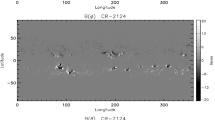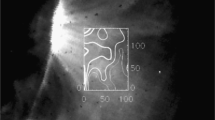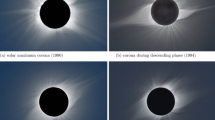Abstract
A calculation of the magnetic field in the solar corona during the total solar eclipse on August 1, 2008, was performed using the PFSS (potential-field source-surface) model in the classical and radial approximation. A brief description is given of the potential model for calculation of the magnetic field in the solar corona by expanding the field in spherical functions and the procedure for visualization of magnetic field lines. Observations of photospheric magnetic fields as made at the Wilcox Solar Observatory were used to find harmonic coefficients. Maps of coronal magnetic field on the solar wind source surface were constructed, and configurations of magnetic field lines in the corona were drawn. The results obtained are compared with the coronal structure observed during the eclipse.
Similar content being viewed by others
References
V. N. Borovik, V. G. Medar’, and A. N. Korzhavin, “First Measurement of the Magnetic Fields in a Coronal Hole from RATAN-600 Radio Observations of the Sun,” Pis’ma Astron. Zh. 25, 250–257 (1999) [Astron. Lett. 25, 206 (1999)].
I. S. Veselovskii and A. V. Ivanov, “Visualization of the Solar Magnetic Field Using Coefficients of Harmonic Expansion in the Potential Approximation,” Astron. Vestn. 40, 470–475 (2006) [Solar. Syst. Res. 40, 432 (2006)].
R. A. Gulyaev and B. P. Filippov, “The Structure of the Solar Corona and the Heliospheric Current Sheet,” Dokl. Akad. Nauk SSSR A 322, 268–271 (1992) [Sov. Phys. Dokl. 37, 4 (1992)].
V. N. Obridko, B. D. Shel’ting, and A. F. Kharshiladze, “Multiparameter Computations of Solar Wind Characteristics in the Near-Earth Space from the Data on the Solar Magnetic Field,” Astron. Vestn. 38, 261–272 (2004) [Solar. Syst. Res. 38, 228 (2004)].
V. N. Obridko, B. D. Shel’ting, and A. F. Kharshiladze, “Calculation of the Interplanetary Magnetic Field Based on Its Value in the Solar Photosphere,” Geomagn. Aeron. 46, 310–319 (2006) [Geomagn. Aeron. 46, 294 (2006)].
M. I. Pishkalo, “Preliminary Prediction of Solar Cycles 24 and 25 Based on the Correlation Between Cycle Parameters,” Kinem. Fiz. Nebes. Tel 24, 370–378 (2008) [Kinem. Phys. Cel. Bodies 24, 242 (2008)].
M. I. Pishkalo and A. R. Baranskii, “Solar Corona during the Total Solar Eclipse on August 1, 2008,” Kinem. Fiz. Nebes. Tel 25, 474–481 (2009) [Kinem. Phys. Cel. Bodies 25, 315 (2009)].
G. V. Rudenko, “Method of Recurrent Integration in Spheric Harmonic Analysis of Solar Magnetic Data,” Issled. Geomagn. Aeron. Fiz. Solntsa, No. 108, 123–134 (1998).
A. F. Kharshiladze and G. K. Ivanov, “Spheric Harmonic Analysis of the Solar Magnetic Field,” Geomagn. Aeron. 34(4), 22–28 (1994).
M. D. Altschuler, R. H. Levine, M. Stix, and J. Harvey, “High Resolution Mapping of the Magnetic Field of the Solar Corona,” Solar Phys. 51, 345–375 (1977).
M. D. Altschuler and G. Newkirk, “Magnetic Fields and the Structure of the Solar Corona,” Solar Phys. 9, 131–149 (1969).
K.-S. Cho, J. Lee, D. E. Gary, et al., “Magnetic Field Strength in the Solar Corona from Type II Band Splitting,” Astrophys. J. 665, 799–804 (2007), doi:10.1086/519160.
G. B. Gelfreikh, N. A. Pilyeva, and B. I. Ryabov, “On the Gradient of Coronal Magnetic Fields from Radio Observations,” Solar Phys. 170, 253–264 (1997).
J. T. Hoeksema, “The Solar Magnetic Field 1985 Through 1990,” Report CSSA-ASTRO 91-01 (1991).
J. T. Hoeksema and P. H. Scherrer, “The Solar Magnetic Field 1976 Through 1985,” Report UAG-94, World Date Center A for Solar-Terrestial Physics (Boulder, 1986).
Y. Q. Hu, X. S. Feng, S. T. Wu, and W. B. Song, “Three-Dimensional MHD Modeling of the Global Corona Throughout Solar Cycle 23,” J. Geophys. Res. A 113(3) (2008), doi:10.1029/2007JA012750.
R. Lionello, J. A. Linker, and Z. Mikíc, “Multispectral Emission of the Sun During the First Whole Sun Month: Magnetohydrodynamic Simulations,” Astrophys. J. 690, 902–912 (2009), doi:10.1088/0004-637X/690/1/902.
P. Riley, J. A. Linker, and Z. Mikíc, “An Empirically-Driven Global MHD Model of the Solar Corona and Inner Heliosphere,” J. Geophys. Res. A 106, 15889–15902 (2001).
P. Riley, J. A. Linker, Z. Mikíc, et al., “A Comparison Between Global Solar Magnetohydrodynamic and Potential Field Source Surface Model Results,” Astrophys. J. 653, 1510–1516 (2006), doi:10.1086/508565.
G. V. Rudenko, “Extrapolation of the Solar Magnetic Field within the Potential-Field Approximation from Full-Disk Magnetograms,” Solar Phys. 198, 5–30 (2001).
G. V. Rudenko, “On the Validity of Application of the Radial Approximation for the Photospheric Field,” Solar Phys. 220, 1–20 (2004).
K. H. Schatten, J. M. Wilcox, and N. F. Ness, “A Model of Interplanetary and Coronal Magnetic Fields,” Solar Phys. 6, 442–455 (1969).
E. J. Smith, “The Heliospheric Current Sheet,” J. Geophys. Res. A 106, 15819–15832 (2001).
L. Svalgaard, T. L. Duvall, and P. M. Scherrer, “The Strength of the Sun’s Polar Field,” Solar Phys. 58, 225–240 (1978).
J. S kora, O. G. Badalyan, and V. N. Obridko, “Connections Between the White-Light Eclipse Corona and Magnetic Fields Over the Solar Cycle,” Solar Phys. 212, 301–318 (2003).
Y.-M. Wang, J. B. Biersteker, N. R. Sheeley, et al., “The Solar Eclipse of 2006 and the Origin of Raylike Features in the White-Light Corona,” Astrophys. J. 660, 882–892 (2007).
Y.-M. Wang and N. R. Sheeley, “On Potential Field Models of the Solar Corona,” Astrophys. J. 392, 310–319 (1992).
J. M. Wilcox and A. J. Hundhausen, “Comparison of Heliospheric Current Sheet Structure Obtained from Potential Magnetic Field Computations and from Observed Polarization Coronal Brightness,” J. Geophys. Res. 88, 8095–8096 (1983).
H. Yoshimura, “Solar-Cycle Evolution of the Coronal General Magnetic Field of 1959–1974 and the Synchronous Variation of High-Speed Solar Wind Streams and Galactic Cosmic Rays,” Solar Phys. 54, 229–258 (1977).
Author information
Authors and Affiliations
Corresponding author
Additional information
Original Russian Text © M.I. Pishkalo, 2010, published in Kinematika i Fizika Nebesnykh Tel, 2010, Vol. 26, No. 3, pp. 15–33.
About this article
Cite this article
Pishkalo, M.I. Calculation of magnetic fields in the solar corona during the total solar eclipse on August 1, 2008, in the potential approach. Kinemat. Phys. Celest. Bodies 26, 104–116 (2010). https://doi.org/10.3103/S0884591310030025
Received:
Published:
Issue Date:
DOI: https://doi.org/10.3103/S0884591310030025




